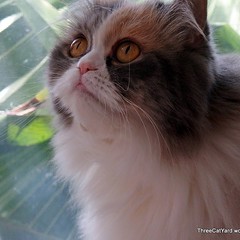 Genetic Fun Fact number 56: All cats are tabby cats, because they all have a tabby gene. Julius above there is a Classic Pattern Tabby , and to show it his genes must be T[b]/T[b]. We know this because this pattern is recessive to the others. The classic pattern is more common in Britian (which might explain the b identifier). The main difference is the large swirl or bullseye on the side.
Genetic Fun Fact number 56: All cats are tabby cats, because they all have a tabby gene. Julius above there is a Classic Pattern Tabby , and to show it his genes must be T[b]/T[b]. We know this because this pattern is recessive to the others. The classic pattern is more common in Britian (which might explain the b identifier). The main difference is the large swirl or bullseye on the side.
The more common is the Mackerel Tabby gene (T). This is the familiar tabby with vertical stripes on the side. This pattern dominates T[b], but is recessive to T[a].
T[a] is the agouti Tabby pattern, or ticked tabby. The best example of these cats is the Abyssinian breed. You can imagine what these cats look like if you look at Juilius and imagine all his black stripes replaced with the ‘background’ color.
The hairs between the stripes are agouti hairs. In these hairs, the pigment is not solid color all along the shaft, but a ‘dotted’ pattern of color, then no color, then color. Between the color is an area filled with the orange pigment, but ‘shredded’ to be less intense. This coloring, called Rufousing, can vary due to other genes. Julius has a pretty strong ‘brown’ coloring to almost orange. Other tabbys have weaker tint, appearing grey.
So in the T[a] tabby, most of the body is entirely agouti, with only the face, head, and legs showing tabby stripes. In the others, the agouti is the “between stripe” fur.
So how do you get a solid cat? That’s for next time.
Note: I’ve put this and some additional genetic information in a separate page for easy reference. I hope you find it useful.


